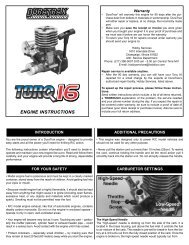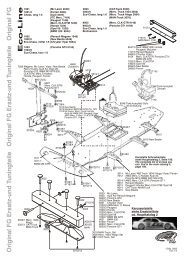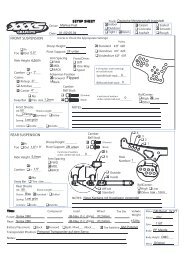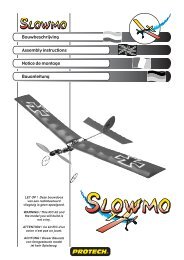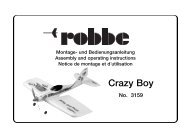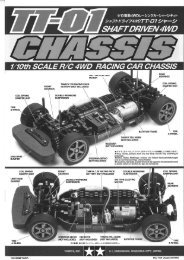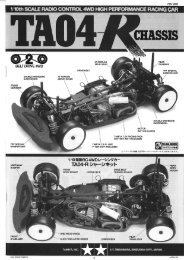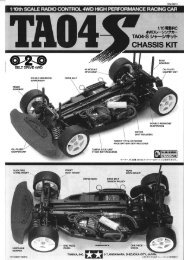Robbe Cardinal.pdf - RCtube.eu
Robbe Cardinal.pdf - RCtube.eu
Robbe Cardinal.pdf - RCtube.eu
Create successful ePaper yourself
Turn your PDF publications into a flip-book with our unique Google optimized e-Paper software.
Baustufe 3, RC-Einbau<br />
Nr. Bezeichnung, Maße in mm Stück<br />
3.1 Höhenruderservo 1, n.e.<br />
3.2 Seitenruderservo 1, n.e.<br />
3.3 Höhenrudergestänge, eins. Z, Ø 1,2 x 570 1<br />
3.4 Seitenrudergestänge, eins. Z, Ø 1,2 x 570 1<br />
3.5 Führungsröhrchen, Höhe, Ø 3,2 x 430 1<br />
3.6 Führungsröhrchen, Seite, Ø 3,2 x 320 1<br />
3.7 Empfänger 1, n.e.<br />
Bild 15<br />
- Servos 3.1 und 3.2 in die Servoschächte des Rumpfs<br />
einsetzen, dabei die Kabel nach vorn zum<br />
Empfängerschacht führen. Servos mit einigen Tropfen<br />
Epoxy sichern. St<strong>eu</strong>erscheibe vom Höhenruderservo<br />
demontieren.<br />
- Die Servos mit der Fernst<strong>eu</strong>erung in N<strong>eu</strong>tralstellung<br />
bringen.<br />
- Das Höhenrudergestänge 3.3 von unten in der<br />
St<strong>eu</strong>erscheibe einhängen. Führungsröhrchen 3.5 aufschieben.<br />
St<strong>eu</strong>erscheibe so aufstecken, daß sich etwa<br />
ein Winkel von 30° zur Mittenposition ergibt.<br />
Bilder 16 und 17<br />
- Das Höhenrudergestänge 3.3 so nach hinten führen,<br />
daß es am Rumpfende mittig austritt.<br />
- Das Seitenrudergestänge 3.4 von oben in der<br />
St<strong>eu</strong>erscheibe einhängen, mit Führungsröhrchen 3.6<br />
versehen und nach hinten zum rechten Rumpfaustritt<br />
verlegen.<br />
- Das Höhenrudergestänge befindet sich unten.<br />
Bild 18<br />
- Die Litzenantenne des Empfängers 3.7 abwickeln.<br />
- Regler und Servos an den entsprechenden<br />
Empfängerkanälen anschließen.<br />
- Den Empfänger in den Empfängerschacht eindrücken.<br />
Die Litzenantenne wird bei Fertigstellung des Modells<br />
zum Seitenleitwerk verlegt. Der Führungsröhrchen-Rest<br />
kann zum Verlegen der Antenne im Rumpf verwendet<br />
werden.<br />
Bauanleitung, Assembly instructions, Notice de montage<br />
<strong>Cardinal</strong><br />
Stage 3, RC installation<br />
No. Description, size in mm No. off<br />
3.1 Elevator servo 1, N.I.<br />
3.2 Rudder servo 1, N.I.<br />
3.3 Elev. pushrod, one Z-bend, 1.2 Ø x 570 1<br />
3.4 Rudder pushrod, one Z-bend, 1.2 Ø x 570 1<br />
3.5 Elevator pushrod sleeve, 3.2 Ø x 430 1<br />
3.6 Rudder pushrod sleeve, 3.2 Ø x 320 1<br />
3.7 Receiver 1, N.I.<br />
Fig. 15<br />
- Place the servos 3.1 and 3.2 in the servo wells in the<br />
fuselage, and run the leads forward to the receiver bay.<br />
Secure each servo with a few drops of epoxy. Remove<br />
the output disc from the elevator servo.<br />
- Set the servos to n<strong>eu</strong>tral (centre) from the transmitter.<br />
- Connect the pre-formed end of the elevator pushrod 3.3<br />
to the servo output disc from the underside. Slip the pushrod<br />
sleeve 3.5 onto the pushrod. Fit the output disc on<br />
the servo, angled back by about 30º as shown.<br />
Figs. 16 and 17<br />
- Run the elevator pushrod 3.3 back until it exits the tail<br />
end of the fuselage in the centre.<br />
- Connect the rudder pushrod 3.4 to the output disc from<br />
the top, slip the pushrod sleeve onto it and route it down<br />
the fuselage to the tail end, exiting the fuselage through<br />
the right-hand slot.<br />
- The elevator pushrod should be underneath the rudder<br />
pushrod.<br />
Fig. 18<br />
- Unwind the flexible aerial attached to the receiver 3.7.<br />
- Connect the speed controller and servos to the appropriate<br />
receiver sockets.<br />
- Push the receiver into the receiver bay. During the final<br />
stages of construction the receiver aerial will be routed<br />
to the fin. Fit the remaining piece of pushrod sleeve in<br />
the fuselage and run the receiver aerial through it.<br />
11<br />
No.<br />
3026<br />
Stade 3, mise en place de l’ensemble de réception<br />
N° Désignation, cotes en mm Nbre de pièces<br />
3.1 servo de la gouverne de profond<strong>eu</strong>r 1, n.c.<br />
3.2 servo de la gouverne de direction 1, n.c.<br />
3.3 tringle, profond<strong>eu</strong>r, un. Z, Ø 1,2 x 570 1<br />
3.4 tringle, direction, un. Z, Ø 1,2 x 570 1<br />
3.5 tube-guide, profond<strong>eu</strong>r, Ø 3,2 x 430 1<br />
3.6 tube-guide, direction, Ø 3,2 x 320 1<br />
3.7 récept<strong>eu</strong>r 1, n.c.<br />
Fig. 15<br />
- Installer les servos 3.1 et 3.2 dans les logements de<br />
servo du fuselage en tirant le cordon vers l’avant vers le<br />
compartiment du récept<strong>eu</strong>r. Fixer le servo avec quelques<br />
gouttes de colle époxy. Démonter le palonnier circulaire<br />
du servo de la gouverne de profond<strong>eu</strong>r.<br />
- Amener les servos au n<strong>eu</strong>tre à l’aide de l’ensemble de<br />
radiocommande.<br />
- Accrocher la tringle de la gouverne de profond<strong>eu</strong>r 3.3<br />
par-dessous au palonnier circulaire. Mettre le tubeguide<br />
3.5 en place. Mettre le palonnier circulaire en<br />
place de telle manière à ce qu’un angle de 30° environ<br />
apparaisse par rapport à la position médiane.<br />
Fig. 16 et 17<br />
- Amener la tringle de la gouverne de profond<strong>eu</strong>r 3.3 vers<br />
l’arrière de sorte qu’elle réapparaisse au mili<strong>eu</strong> de la<br />
qu<strong>eu</strong>e du fuselage. Accrocher la tringle de la gouverne<br />
de direction 3.4 par le haut dans le palonnier circulaire,<br />
la munir du tube-guide 3.6 et la disposer vers l’arrière<br />
vers la sortie droite de la qu<strong>eu</strong>e du fuselage. La tringle<br />
de la gouverne de profond<strong>eu</strong>r se trouve en bas.<br />
Fig. 18<br />
- Développer l’antenne souple du récept<strong>eu</strong>r 3.7.<br />
- Raccorder le variat<strong>eu</strong>r et les servos aux voies correspondantes<br />
du récept<strong>eu</strong>r. Pousser le récept<strong>eu</strong>r dans le<br />
compartiment du récept<strong>eu</strong>r. Lorsque le modèle sera terminé,<br />
l’antenne souple du récept<strong>eu</strong>r sera disposée vers<br />
la dérive. Le reste du tube-guide p<strong>eu</strong>t être employé pour<br />
disposer l’antenne dans le fuselage.



